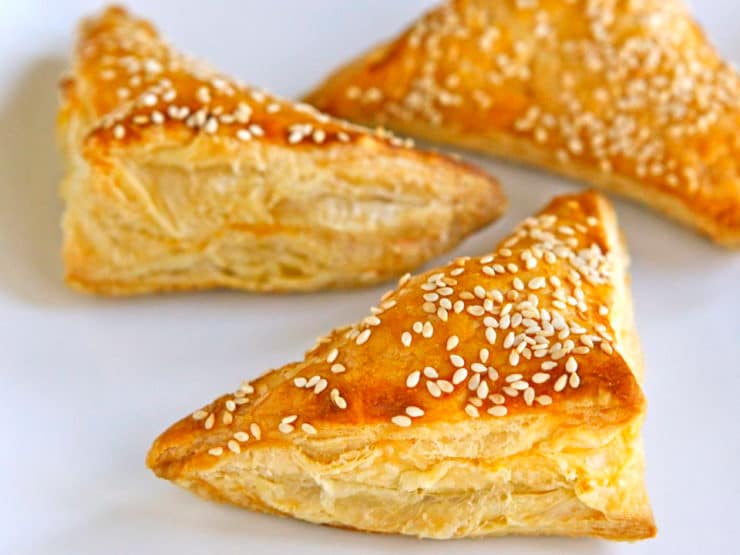
Bourekas are delicious Middle Eastern hand pies. These baked, stuffed pastries are popular in Israel and throughout the Middle East. Different versions of this turnover pastry exist all over the world—knishes, calzones, samosas, bridies, and strudel are all regional variations on the same concept. Bourekas originated in Asia as a deep-fried filled dumpling known as a burga. When the Turks of central Asia moved to what is now the country of Turkey, they brought their stuffed burga dumplings with them. Over time, the dumpling evolved into a variety of stuffed, layered pastries known as börek. Sephardic Jews who settled in Turkey adopted the pastry, merging it with their version of the same dish (empanada) and adapting it to make it kosher. Börek + empanada = boureka. The boureka was born!
Bourekas are made with a variety of savory fillings, including cheese, meat, spinach, and eggplant. They are generally made with either puff pastry or filo (phyllo) dough, and served as appetizers, alongside a meal, or as a portable snack. I like to serve them with homemade soup for a light and tasty winter meal. Paired together with scrambled eggs, they would make a great breakfast. Of the many boureka varieties out there, cheese bourekas are my favorite. They are super easy to make, especially if you use store-bought puff pastry or filo dough. They also freeze well, which means you can make them ahead and pop them in the oven just before your meal. I keep a stash in the freezer for unexpected company; they’re such a treat with tea or coffee. Be sure to use a quality feta cheese. I like Israeli feta, it’s creamy and slightly sweet with the perfect texture for bourekas. A good quality Greek feta will work well, too. Don’t buy the pre-crumbled variety—a block is better, and it’s easy enough to crumble yourself. If you can’t find kashkaval cheese, substitute another ¼ cup of feta cheese. They’ll still taste great.
Some people like making bourekas with puff pastry (store bought or homemade), while others swear by filo (phyllo) dough. Puff pastry bourekas are softer and thicker, while filo bourekas are lighter, crisper, and more delicate. I like them both ways. For this particular blog, I used puff pastry. They can just as easily be made using filo dough – click here to learn how. The cheese filling recipe would remain the same for either style of boureka, so feel free to experiment to figure out which style you like best.
These Cheese Bourekas are also a fun recipe option for the upcoming Jewish holiday of Purim. Purim is sometimes celebrated with a meatless menu in honor of Queen Esther, who became a vegetarian to keep kosher in the palace of her non-Jewish husband King Ahasuerus. Stuffed foods are traditional for Purim, as are triangle-shaped foods. These Cheese Bourekas are both triangular and meatless, making them a great choice for your Purim menu!
This recipe creates lightly stuffed bourekas that should not overflow or leak out with cheese. If you’d like to stuff it with more cheese, you can double the filling– just know that the filling may leak out a bit when baking.
I have shared this recipe with my friends at Zabar’s.com. Click here to check out their amazing site.
Recommended Products:
We are a participant in the Amazon Services LLC Associates Program, an affiliate advertising program designed to provide a means for us to earn fees by linking to Amazon.com and affiliated sites. As an Amazon Associate I earn from qualifying purchases.
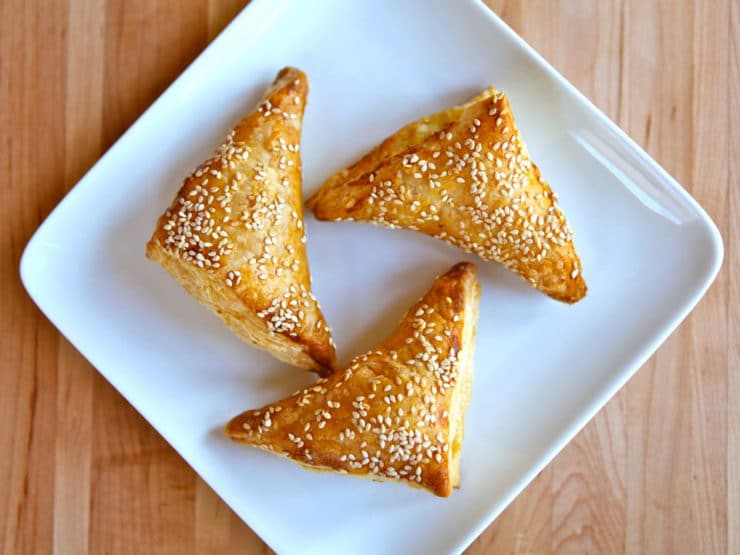
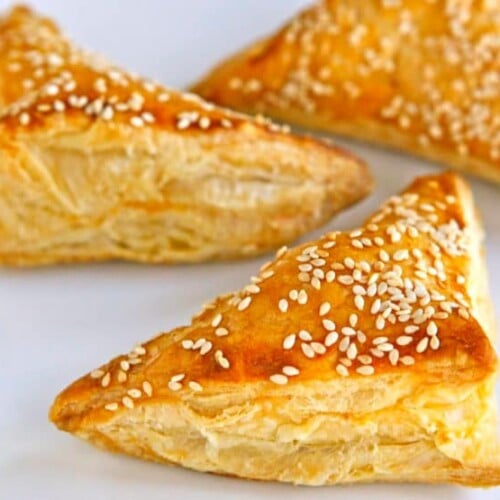
Cheese Bourekas
Ingredients
- 2 sheets puff pastry (you can also use filo dough, click here for directions using filo)
- 1/2 cup crumbled feta cheese
- 1/3 cup grated kashkaval cheese (or substitute another 1/3 cup feta)
- 1/3 cup ricotta cheese
- 1 large egg
- Salt and pepper
- 1 large egg yolk
- 1 tablespoon sesame or poppy seeds for topping (optional)
- Nonstick cooking oil spray
NOTES
Instructions
- Preheat oven to 350 degrees F. In a mixing bowl, combine feta, kashkaval, ricotta, egg, a pinch of salt and a pinch of black pepper (if using all feta cheese, you may not need to add any salt). Use a fork to mix ingredients together till well blended. Make sure to break up any large crumbles of feta with the fork. Reserve mixture.

- On a smooth, clean, lightly floured surface, unfold one of your puff pastry sheets. Use a rolling pin to roll out the sheet to a 12x12 inch square. If using homemade puff pastry, roll your dough out to the same size - a 12”x12” square. Cut the sheet of puff pastry dough into 9 equal-sized squares, each about 4”x4” large.

- Place 1 scant tablespoon of the cheese filling in the center of each dough square.

- Fold the dough squares by grasping one corner and folding it over to the opposite corner to make triangles. Pinch firmly along the outer open edge of the triangles to seal. If you're having trouble sealing the dough and getting it to stick together, wet your finger with a bit of water and run it around the edge of the square before folding-- this will help it stick together.

- You can also crimp the edges with the tines of a fork, if you wish.

- Repeat this process for the second sheet of puff pastry—roll out the pastry, cut into squares, add filling, and seal the triangles.

- Spray your baking sheets with nonstick cooking spray or line with parchment paper. Place 9 bourekas on each sheet, evenly spaced, giving them some room to expand during baking.

- In a small bowl, whisk together the egg yolk and 2 tsp of cool water. Use a pastry brush to brush a light layer of the egg wash onto the surface of each boureka.

- Sprinkle the bourekas with sesame or poppy seeds, if desired.

- Bake the bourekas for about 30 minutes, switching the baking sheets between the upper and lower racks halfway through cooking. Bake till golden brown and cooked through.Serve warm. Store in a sealed container or plastic zipper bag.

- To freeze bourekas: prepare, fill, and seal the pastries. Do not coat with egg wash or bake. Place the unbaked pastries in a Tupperware or plastic bag in single layers, separating each layer of bourekas with a piece of parchment paper or wax paper to keep them from freezing together. Freeze.

- When ready to bake, take the bourekas out of the freezer (no need to defrost) and arrange them on a baking sheet sprayed with nonstick oil. Coat with thin layer of egg wash and sesame or poppy seeds, if desired. Bake at 350 degrees for 30-40 minutes till golden brown.

Nutrition

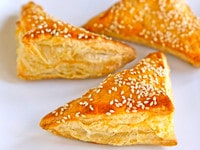
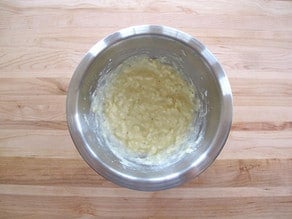
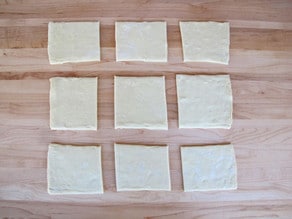
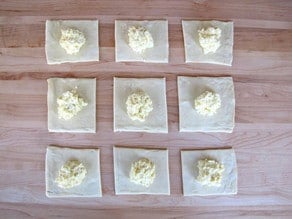
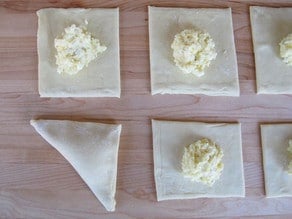
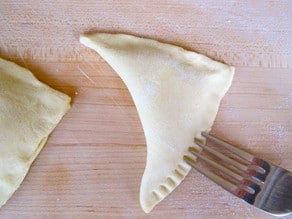
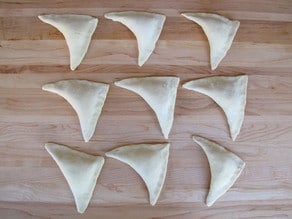
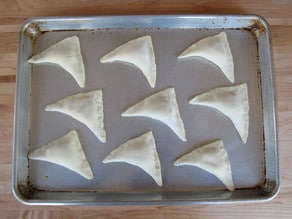
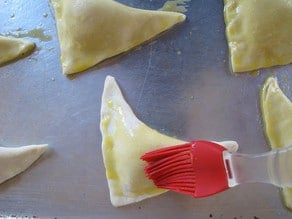
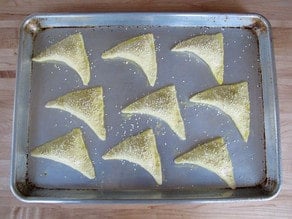
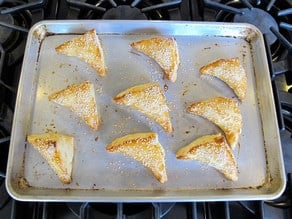
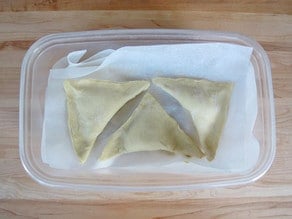
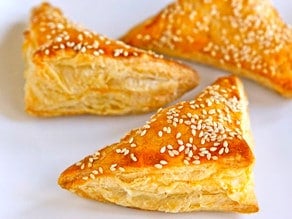


Looks yummy! How do we store the already baked Bourekas?
With cheese bourekas it’s safest to store in the refrigerator and reheat before eating.
Hiya
i am from England doing an exam (GCSE) in food and nutrition and have it difficult to get hold of the right kosher recipe that actually looks good and….i came across you and have used numerous recipes and am passing really well…
Huge huge thanks from a fan in London
Hi Tori,
Well these look pretty amazing! I am unsure if when you say “another” 1/3 cup feta, this means the total feta will be 2/3 cup?
Hopefully you will answer so I can make these this weekend!
Thanks,
Nancy
Hi Nancy – it means, if you used 1/2 cup of feta, and you cannot find kashkaval, you can use an additional 1/3 cup of feta – so the total would be 1/2 cup + 1/3 cup feta.
Dear Tori, originally from Brooklyn, now living in Alaska and missing many of the delicacies from the neighborhood. Your website, its content, historical facts, and recipes are wonderful!
This morning we made your cheese bourekas for the first time and felt like being transported home…WOW….delicious!!! Thank you for sharing all your culinary knowledge & recipes!!! S & T Reder Wasilla Alaska
Aww thanks Sam and Trudy! I appreciate your message. 🙂
Hey , should I use crumbled feta or fresh feta and which brand is the best
I prefer getting a block of feta and crumbling it, the flavor tends to be better. I wouldn’t recommend a specific brand here, but if you have a local Middle Eastern or Mediterranean market with a deli counter they usually have great quality feta. Good luck!
I love your recipe of Bourekas.. Shalom!
Can I use butter sheets instead of cooking oil spray ??
Not sure what butter sheets are Athar, sorry I can’t advise you here! If it’s anything similar to parchment paper it should work just fine.
I’m so sorry because I defined the baking sheets as butter sheets , thank you !
Im going to use the baking sheets
When I was in Israel last year, the food was absolutely divine. I fell head over heels for the chicken shawarma with tahini sauce, but what I fell even harder for were these delightful, savory pastries we would have every single morning at almost every place we were. I would actually take extras and bring them along and they would be my snack on the bus for wherever we were going that day. I cannot wait to make them for my family! I’m even more thrilled to see that it is an easy pastry to make!
This is a good recipe, thanks for your efforts
Glad you enjoyed it!
Thank you! Easy recipe. I substituted kashkaval cheese with Edam cheese. They came out with very soft and gentle cheese filling.
Is is possible to use a different filling for the bourekas i.e. spinach, or potato knish filling? Do you have a good recipe for Jewish apple cake?
Yes, you can use any number of fillings for these bourekas. I have a Honey Apple Cake recipe that is quite popular here: https://toriavey.com/toris-kitchen/honey-apple-cake/
The feta cheese ingredient in this recipe can be replaced by another substitute of it like cheddar cheese? Will it have any problem if i use it ?
No problem, but the filling will be more stringy and less creamy. You may also need to adjust salt content, feta is saltier than cheddar.
Made bourekas according to this recipe many times since it was published. It’s perfect and precise. Tastes just like home (Israel). Tory, thank you so much for sharing ?
FYI, if you guys are going to use puff pastry do not let the egg wash touch the sides of the pastry. Doing so will not let the puff pastry rise to its fullest potential. If you’re making the puff pastry from scratch, you want to showcase the hard work you did while lamenting.
This is so good! The bourekas can be used for so many different things. They are perfect for breakfast, add a salad or soup and you have a wonderful lunch or fabulous light meat free dinner. My original plan is to serve them as an hors d’oeuvres for an upcoming event. I grew up with a Jewish Greek background and these types of pastries were a regular fare with many different fillings. Alas, I never mastered their dough but using puff pastry I can recreate those long lost delicacies. Thank you for sharing this recipe.
Love This recipe. I’m going to try it for Sunday brunch!
Thanks for sharing! I have company coming next week and was trying to figure out what to make ahead of time. I especially appreciate your tips on freezing these. Your instructions are clear, concise and easy to follow. Keep up the good work!
Glad this was helpful Viasta!
Thanks I will. Love feta
Thanks Tori, I din’t know of any kosher markets around Toledo anymore. I’m not sure of Middle Eastern ones either
If you can find a nice quality feta it will make a great sub, just make sure you don’t oversalt the filling– feta can be pretty salty. 🙂
What is Kashkaval cheese?
Bev, Kashkaval is a type of cheese popular in the Middle East. It can be found at most Middle Eastern and kosher markets.
I used 1/3 cup of cottage cheese instead of grated kashkaval cheese and left out the egg as cottage cheese is pretty moist on its own.
It turned out great. Thanks for the recipe!